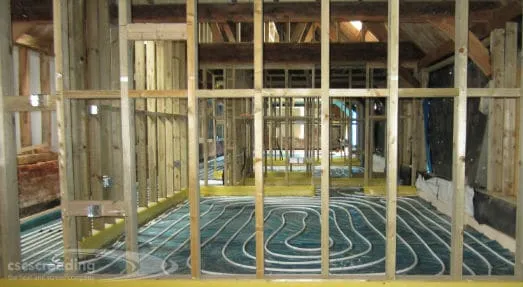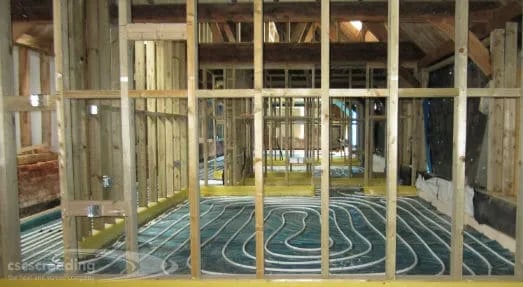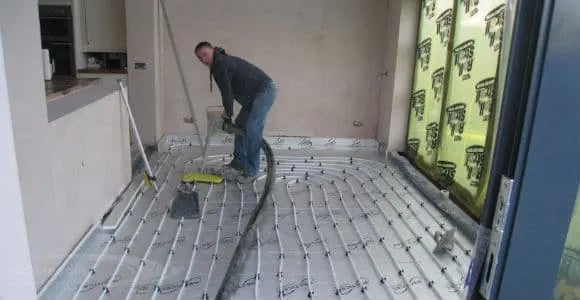
Capture your Competitive Advantage with Underfloor Heating.

Underfloor heating – no matter the building!
Complementing underfloor heating (UFH) with the right screed construction and decorative treatment is critical to deliver floors that meet the highest standards of quality and exceed customer expectations. Which is the best flooring option for UFH?
Ceramic, Stone, Slate, and Terracotta
With the lowest possible tog value (0.0 togs), ceramic, stone, slate, and terracotta are the best flooring alternatives a builder can use for UFH. Excellent thermal conductors, these floors facilitate heat transfer from pipes/electric cables to the floor surface.
The heat-up time depends not only on the tog value but also on the thickness of the tiles and the adhesive bed required. For instance, slate and terracotta tiles are thicker (between 10mm and 20mm) than ceramic tiles (between 8mm and 12mm thick). This means that they need a thicker adhesive bed, which will increase the heat-up time. Once the optimum temperature is reached, a thicker floor will dissipate the same amount of heat as thinner floor surfaces.
Wood and Laminate Flooring
Though there are different types of wood and laminate floors, regular products have a thermal resistance of 0.5 togs, going up to 1.5 togs for 22mm thick boards. The thickness of the floor only increases the heat-up time, without affecting the output. The thermal conductivity of a floor is mainly affected by its density (high-density boards transmit heat much better than low-density products).
Engineered timber is usually preferred because it has a great structural stability, which allows it to perform well with fluctuating temperatures. When this flooring option is selected, the floor surface temperature should be kept below 27°Celsius, or the floor will deteriorate over time due to excessive heat. Quick-step laminate flooring is another valid option for UFH.
Vinyl and Linoleum Flooring
Both vinyl and linoleum allow a good heat output, having a tog value of 0.5 togs. Considering that the recommended maximum floor surface temperature for vinyl and linoleum flooring is 26°Celsius, not all vinyls and linoleums are compatible with UFH. Therefore, it is advisable to check the manufacturer’s recommendations before opting for a certain type of vinyl or linoleum for UFH.

Underfloor heating for any size job
Carpet
With a thermal resistance ranging between 1 and 1.5 togs, carpets are poor heat conductors. For a UFH system to operate efficiently, the carpet combined with the underlay should have a maximum tog value of 2.5 togs. As with other floor finishes, the denser the carpet, the better the output will be.
Regardless of density, recommending clients to combine wood flooring with rugs is the worst possible advice a builder or an installer can give. Both wood flooring and rugs act as insulators rather than conductors, significantly reducing the heat output from any UFH system.
The maximum amount of heat that solid floors distribute ranges between 70 watts/sq.m. for timber, vinyl, and linoleum floors and 100 watts/sq.m. for ceramic, slate, stone, and terracotta. This might be enough if the right insulation is laid over the concrete slab to prevent heat loss. If the wrong type of insulation is applied, the UFH system may fail to provide enough heat to maintain a constant temperature.
Are you looking for a reliable floor screeding and underfloor heating contractor? With more than 27 years of experience in designing, supplying, and installing floor screeding and underfloor heating systems, BuilderScreed has become the preferred supplier for a large number of builders across South East England. Call us at 0845 500 4055 for professional advice or for a free estimate on your next project.

You may also be interested in Howe Farm Hambledon: Floor screed over underfloor heating or Prepping up for underfloor heating
BuilderScreed is a division on CSC Screeding Ltd
